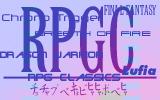
 |
|
|
Puzzles
| Puzzles |
Vagrant Story has a puzzle element to it. It's not that prominent, but it's there. The puzzles all consist of moving different types of cubes around to create bridges across gaps or platforms from which to jump up to a ledge. The puzzles are mostly concentrated in the last parts of the game, and there aren't many of them, but they can still provide formidable obstacles. The toughest puzzles (the only ones of concern, really) are in the last room of the Limestone Quarry, the side rooms in the Temple of Kiltia, two rooms in The Great Cathedral, and two rooms in the Iron Maiden B1. If you're having trouble with one of them, just go to the section of the walkthrough corresponding to the location of that particular puzzle and look it up. Sometimes, puzzles can be bypassed entirely, or made significantly easier, if you use a Faerie Wing item. This will make your jumps a lot higher and longer, making it easier to get to the ledge you want to go to. This section explains the basics of Vagrant Story's puzzles by giving an overview of the different types of cubes that comprise them. |
| Normal Box |
This is just a wooden box. If you get out of Battle Mode, walk up to it and press X, you'll pick it up. Now you can carry it around and place it anywhere you want by pressing X again. You won't be able to jump very high with it, so your mobility will be severely limited. Also, if you open up a battle sphere near it, you will be able to target it and destroy it with one hit. You'll need to do that when it's blocking your way to another type of cube. |
| Push Crate |
This looks like a wooden box but with steel on the edges. You can't pick it up, but if you walk up to it and press X, you'll push it one tile away from yourself, assuming there are no obstacles in its way. You can push them off ledges but not up onto them (obviously). Naturally, if you can't get behind them, you can't push them. Also, you can destroy them just like normal boxes. |
| Stone Cube |
This looks like a stone block. It works just like a push crate, with the sole difference being that you can't destroy it by any means. Sometimes, it will display a number on top of it when you approach it. Then, you'll see that every time you push it, the number decreases by one. If the counter hits zero, the cube will disappear. If there's no number to begin with, the cube can be pushed an infinite number of times. |
| Sliding Cube |
This is a blue cube with a glowing bottom. You push it just like you'd push a stone cube, but it will keep sliding in the direction you push it until it hits an obstacle, unlike push crates and stone cubes. Like stone cubes, sliding cubes are indestructible. Generally, what you'll need to do in puzzles is manoeuvre other cubes in the way of sliding cubes to act like obstacles, so they'll stop the sliding cube when you slide it at them, so you'll be able to slide the cube again from the side or something like that. Let's say you need to get a sliding cube east halfway across a room, then north to the wall. You'd need to place some other cube east across from the sliding cube, close to the middle of the room. Then, you'd slide the sliding cube east, and it would hit the other cube and stop, at which point you could get around it and push it north. |
| Magnetic Cube |
This is a blue or red cube with a glowing top. You can pick it up just like a box, but it has another odd property. If you were to pick up a blue magnetic cube and put it on another blue magnetic cube, the top cube would jump up and hover in the air above the bottom cube. However, if you put a blue cube on a red cube, the top cube will glue itself to the bottom cube and you won't be able to pick it up again. This reflects what happens when you put similar and opposite poles of two magnets together. You can't destroy magnetic cubes. You can, however, pick hovering cubes up from their position in the air, if you're at the right height, and you can climb up and stand on hovering cubes at your leisure. The point of this is that you can get a high platform using only two blue magnetic cubes, meaning that you'll have more height for a jump. |
|
|